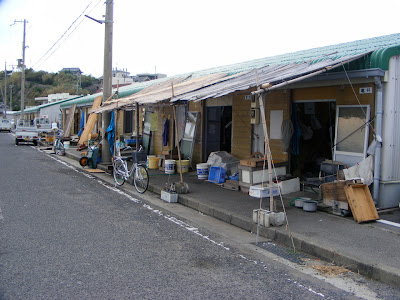After navigating through the concrete jungle of Tokushima and the spaghetti junctions around the toll road we managed to take the shortest links to Awaiji, crossing what is said to be the world's longest suspension bridge, from Naurito(Naruto)-kita to Awaijishima-minami, where we drove up the west coast looking for a place to stop the night.

These two maps show how hairy it can be trying to navigate avoiding the very expensive Japanese motorways while still getting from A to B. Initially we crossed the bridge to the far left, having struggled to get onto it through the tortuous set of clover leaves visible in the upper enlargement, then finding it led nowhere near the Naruto bridge to Awaji. We then backtracked to the right-hand pair which then tried to lead us onto the larger motorway bridge. It was only when we crossed the smaller parallel bridge on the left that we found it had a spaghetti underpass to the right following the coast without paying a toll fee until we hit the Naruto bridge proper.





The Naruto channel is renowned for its fast currents reaching 20 kph in spring tides, causing giant whirlpools to form, as these internet images show.











We then stopped at a shrine island with an extraordinary bridge promenade ideal for line fishermen.
















Tonight we're perched on a little spit by a rocky outcrop with a little shrine on it beside a small fishing village on the island of Awaji just north of Goshiki, stopping at this fishing village. Goshiki has a famous beach lined with pine trees but when we stopped in there were only a few lugubrious places we could park. Here its one of those sanctuaries that pop into the view of the lonely traveler scanning the horizon for a place to lay their heads as they pass, never to return. We pulled in almost by accident, although we always stop at the little shrines with tori gates that adorn little outcrops and islands. There are a few other Japanese camping here, fishing off the breakwater that encloses the village port. There are also clean toilets and showers and places to wash our clothes almost the first time we have gypsy camped amid a full suite of domestic luxuries and the first night it hasn't been sweltering hot and sticky virtually since we arrived.
This in itself is a worrying sign amid reports that the North West Passage has opened, that the Arctic ice is disintegrating leading to a runaway affect as white polar shows are replaced by deep blue ocean which absorbs the radiant heat of the sun further exacerbating global warming and the rising oceans.






Here we are now just a kilometre or so inland of our night stop by a Buddhist temple eating breakfast.










The north end of Awaji was the epicentre of the Kobe earthquake, and there is a museum on the coast to the earthquake situated on part of the fault line that abruptly shifted.

















As we left Awaiji we realized we were now taking the world's longest suspension bridge, a much huger more imposing structure than the one we entered the island from, totally dwarfing even the largest trucks and far larger than the Golden Gate in San Francisco.
























0 件のコメント:
コメントを投稿